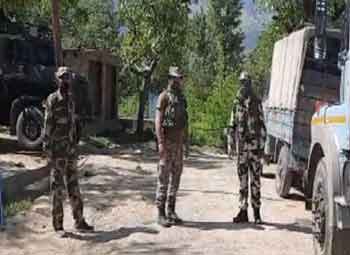Naxal Leadership Weakens as Security Forces Intensify Operations
JAGDALPUR – The stronghold of left-wing extremism in India is witnessing a decisive shift as security forces prepare for one of the biggest counterinsurgency operations in Chhattisgarh. With the top echelons of the Naxalite movement significantly weakened, the remaining Central Committee (CC) and Politburo leaders have become the primary targets.
Recent intelligence suggests that Naxalite leadership is on the brink of collapse as successive counterinsurgency operations have eliminated or incapacitated key figures. Reports indicate that only a handful of high-ranking members remain active, primarily in the deep forests of Maoist-dominated regions like Maad and the border areas of Bastar.
Security Forces Prepare for Final Offensive Against Naxal Leaders
The Ministry of Home Affairs (MHA) has set a March 2026 deadline for security forces to dismantle the last remnants of the insurgent leadership. Under this directive, elite commando units, state police, and paramilitary forces are gearing up for a strategic offensive targeting top Naxal leaders.
In the past few years, major leaders such as Rammanna, Haribhushan, Ramakrishna, and Katamma Sudarshan have either died due to illness or been neutralized in encounters. In recent months, the elimination of high-profile Naxalite leader Chalapathi—who had orchestrated several large-scale attacks—has further destabilized the organization.
Despite these setbacks, intelligence reports confirm that five to seven senior CC members are still operating in Chhattisgarh, particularly in the Maad region and bordering areas. These remaining leaders are now at the top of the hit list as forces move in to end their control over the movement.
Top Naxalite Leaders Under Security Forces’ Radar
The latest reports indicate that several Politburo and CC members are attempting to regroup and protect their leadership. However, increased military action and intensified intelligence operations have left them with dwindling resources and a shrinking support base.
The most wanted leaders, many of whom have bounties of up to ₹1 crore ($120,000) on their heads, are now under constant surveillance. Government agencies have identified key figures still at large and are coordinating with local intelligence units to track their movements.
Significant Naxalite Losses in Recent Operations
- Chalapathi, a senior leader with a long history of orchestrating attacks, was neutralized in a recent encounter in Gariaband.
- Prashant Bose, a top-ranking leader from Jharkhand, was arrested in a high-profile operation.
- Other prominent leaders have been eliminated in Maharashtra, Odisha, and Telangana as part of coordinated counterinsurgency efforts.
With these setbacks, the Naxalite network is facing severe disruption, and its top commanders are running out of safe havens.
Major Military Strategy to Eliminate Remaining Naxal Leadership
The security apparatus in Chhattisgarh is deploying a multi-pronged approach to corner the remaining CC and Politburo members.
1. Enhanced Surveillance and Intelligence Gathering
Security forces are leveraging drones, satellite imaging, and human intelligence networks to track the movements of key Naxalite leaders. High-tech signal interception methods are being used to disrupt Naxal communications and identify hideouts.
2. Coordinated Multi-State Operations
Given the cross-border movement of Naxal leaders, states like Jharkhand, Odisha, Maharashtra, and Telangana are working in tandem with Chhattisgarh forces to ensure no safe passage for fleeing insurgents.
3. Strategic Targeting of Naxal Strongholds
Key areas, including the Maad region and border forests, are under increased military pressure. CRPF battalions, DRG (District Reserve Guard), and STF (Special Task Force) units have been reinforced to tighten the noose around Maoist leaders.
4. Psychological and Economic Warfare
The government is ramping up efforts to cut off the financial and logistical support system of the Naxalites. The surrender policy is also being aggressively promoted, with attractive rehabilitation programs encouraging lower-rank cadres to defect.
Impact of Operations on Naxalite Movement
The steady elimination of top leaders has left the Naxalite movement in crisis. Internal dissent, lack of funding, and loss of key strategists have weakened their influence, particularly in Chhattisgarh, where once-dominant strongholds are crumbling.
Security forces believe that the current phase of the operation could be the final push needed to end the Naxalite insurgency in central India.
Government’s Stance on Counterinsurgency Measures
Authorities remain firm on their objective: complete eradication of Naxalism by March 2026. The Home Ministry, state governments, and intelligence agencies are working in unprecedented coordination to ensure the elimination of remaining insurgents.
Bastar IG Sundarraj P emphasized that the CC leadership has significantly declined, and with continued operations, the remaining members will be neutralized soon. The upcoming mission aims to deal the final blow to Naxal leadership, ensuring peace and security in the region.
Final Phase: The Endgame for Naxalism in Chhattisgarh
The final battle against left-wing extremism is at its most critical juncture. With top leaders being eliminated, the Naxalite movement is now in survival mode. Security forces are determined to wipe out the last remnants and bring an end to decades of insurgency.
The next few months will be decisive, as Chhattisgarh’s security forces and central agencies launch a full-scale crackdown on remaining Naxal leaders. If successful, this operation could mark the beginning of a Naxal-free India—a milestone in the country’s fight against domestic extremism and insurgency.




















